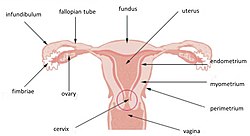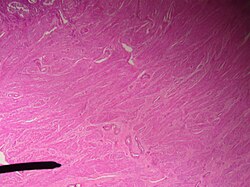Uterine smooth muscle
| Myometrium | |
|---|---|

Uterus and uterine tubes (Myometrium labeled at center right)
|
|

Microscopic slide of the myometrium.
|
|
| Details | |
| Identifiers | |
| Latin | tunica muscularis |
| TA | A09.1.03.025 |
| FMA | 17743 |
|
Anatomical terminology
[]
|
|
The myometrium is the middle layer of the uterine wall, consisting mainly of uterine smooth muscle cells (also called uterine myocytes), but also of supporting stromal and vascular tissue. Its main function is to induce uterine contractions.
The myometrium is located between the endometrium (the inner layer of the uterine wall), and the serosa or perimetrium (the outer uterine layer).
Myometrium has 3 layers: outer longitudinal smooth muscles, middle crisscrossing (figure of eight) muscle fibres, and inner circular fibres. Middle crisscross fibres act as living ligature during involution of the uterus and prevent blood loss.
The inner one-third of the myometrium (termed the junctional or sub-endometrial layer) appears to be derived from the Müllerian duct, while the outer, more predominant layer of the myometrium appears to originate from non-Müllerian tissue, and is the major contractile tissue during parturition and abortion. The junctional layer appears to function like a circular muscle layer, capable of peristaltic and anti-peristaltic activity, equivalent to the muscular layer of the intestines.
The molecular structure of the smooth muscle of myometrium is very similar to that of smooth muscle in other sites of the body, with myosin and actin being the predominant proteins. In uterine smooth muscle, there is approximately 6-fold more actin than myosin. A shift in the myosin expression of the uterine smooth muscle may be responsible for changes in the directions of uterine contractions during the menstrual cycle.
Uterine smooth muscle has a phasic pattern, shifting between a contractile pattern and maintenance of a resting tone with discrete, intermittent contractions of varying frequency, amplitude and duration.
As noted for the macrostructure of uterine smooth muscle, the junctional layer appears be capable of both peristaltic and anti-peristaltic activity.
The resting membrane potential (Vrest) of uterine smooth muscle has been recorded to be between -35 and -80 mV. As with the resting membrane potential of other cell types, it is maintained by a Na+/K+ pump that causes a higher concentration of Na+ ions in the extracellular space than in the intracellular space, and a higher concentration of K+ ions in the intracellular space than in the extracellular space. Subsequently, having K+ channels open to a higher degree than Na+ channels results in an overall efflux of positive ions, resulting in a negative potential.
...
Wikipedia
